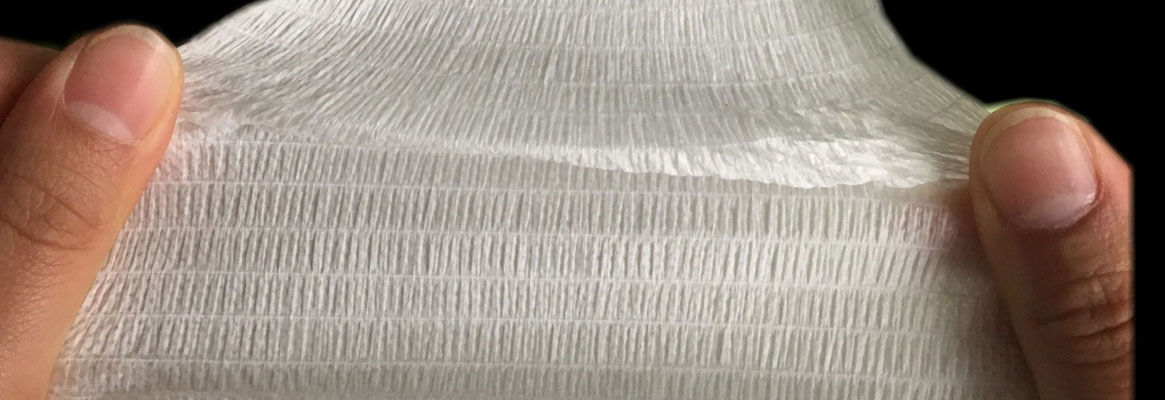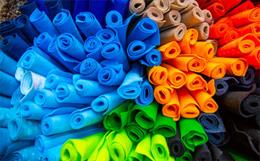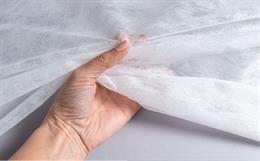Introduction
This report encompasses some of the most interestingprocesses of forming composite elastic nonwoven webs. Elasticity is a desiredproperty in nonwoven webs to be used in bandages, diapers for a tight yetcomfortable fit, garment linings for a body-hugging fit, bandages that shouldbe stretchable to cover the wound well and several other applications where itmay be needed 1). There are multiple processes of making an elasticnonwoven composite. Hence, this report looks into the different processes fromthe product perspective. The general principle of forming an elastic nonwovencomposite is to make two different webs, of which one of the webs is elasticand bonding them together keeping the elastic web stretched while bonding takesplace.
How the two webs are bonded makes the processes differentfrom one another. The following section discusses the different processes offorming such webs using different bonding techniques.
The Processes:
1. By Chemical Bonding 2)
In this process, the product is manufactured by passing alongitudinally oriented nonwoven material over a roller so as to apply anadhesive to one surface of the nonwoven material. At the same time, apolyurethane web is heated and longitudinally stretched and adhered to the nonwovenmaterial. Thereafter, a second nonwoven material is adhered to the othersurface of the polyurethane web to form a laminate consisting of a stretchedinner polyurethane core and outer un-stretched nonwoven fabric layers adheredto the core by the adhesive. Next, the laminate is passed through a moisteningdevice which results in a relaxing of the engagement between the nonwovenfabric outer layers and the adhesive connecting the outer layers to thestretched polyurethane core layer. This allows the stretched polyurethane layerto return to substantially its original length which results in the outernonwoven layers being buckled or undulated to form wrinkles.
Another patent 3) discusses a composite nonwovenelastic web which is composed of a nonwoven elastic web that is joined to afibrous nonwoven gathered web. This process produces a composite nonwovenelastic web which, in its relaxed, non-stretched state, is composed of agathered nonwoven fibrous web that is joined to a nonwoven elastic web with thenonwoven elastic web having been relaxed from a stretched length to a relaxed,non-stretched length so as to gather the fibrous nonwoven gathered web. Animportant feature of the process is that the fibrous nonwoven gatherable web isformed directly onto a surface of the nonwoven elastic web while the nonwovenelastic web is maintained in a stretched and elongated condition. The nonwovenelastic web may be formed by a melt-blowing process or any other process forforming a nonwoven elastic web. For example, the nonwoven elastic web could bean apertured web of an elastic film as opposed to a melt-blown fibrous nonwovenelastic web. The formed nonwoven elastic web has a normal relaxed, non-stretched,nonbiased length. Thereafter, the nonwoven elastic web is elongated by beingstretched to a stretched, biased length.
2. By Needle Punching 4)
In this method, a nonwoven textile layer and a layer ofgenerally elastic material having inherent resilience are positioned to formsuperposed layers. The superposed layers are then needle punched to make acomposite of the two layers. The spacing of the needles and plurality of needlepunching locations are predetermined. The superposed needle punched compositeis then drafted in the machine direction by means of nip rolls within theelastic limits of the generally elastic layer thereby permanently stretchingthe nonwoven textile layer. The composite is then allowed to relax. Thispermits the generally elastic layer to recover its original dimensionssubstantially in response to its inherent resilience whereas the bulk of thenonwoven textile fabric increases between the points of needle punching. Thedraft ratio is selected keeping in mind the desired amount of bulking in the finalcomposite. The draft ratio applied to the laminate is limited by two factors:the elastic limit of the generally elastic layer as well as the capability ofthe nonwoven textile layer to be drafted while maintaining its structuralintegrity. The draft ratios can vary between 1:1 to 4:1 while the most typicalones lie between 1.5:1 to 2:1.
Particularly advantageous nonwoven textile fabrics are those formed of any suitable cardable staple type fibers, either synthetic or natural. Suitable synthetic fibers include polyesters, poly(arylene sulfides), acrylics, polypropylene, and polyamides. Polyester nonwoven fabrics can be advantageously employed in the laminates for thermal insulation such as in clothing. Poly(arylene sulfide) nonwoven fabrics, particularly poly(phenylene sulfide) nonwoven fabrics, can be advantageously employed where high temperatures will be encountered. Nonwoven fabrics of acrylic fibers can be advantageously employed where resistance to ultraviolet radiation is important. Nonwoven textile fabrics of polypropylene fibers can be advantageously employed where a thermal insulation and buoyancy in water is desired. The staple lengths used are generally in the range of 3 to 4 inches while the denier may range between 1.5 to 5.
The generally elastic material can be of any suitable material having inherent resilience which can be drafted an amount within the elastic limit of the material and still regain substantially its original dimensions when allowed to relax. Such materials can include elastic knitted nonwoven fabrics or paper products, as well as elastomeric and rubber foam or solid sheet materials.
Such composites can be used as clothing insulation, high temperature insulation or as flotation media. In general, these laminated nonwoven fabrics can be employed advantageously where increased bulk and surface area are desirable attributes.
3. By Hydroentangling
In the first step of the process, a web is formed of at least two different types of fibers viz. hard fibers and elastomeric fibers. The two types of fibers are uniformly distributed in the web. The hard fiber may be of any staple length or denier suitable for processing on conventional web-making equipment, such as cards, Rando-Webbers, or air-laying equipment. The hard fibers may be of any synthetic fiber-forming material, such as polyesters, polyamides, acrylic polymers and copolymers, vinyl polymers, cellulose derivatives etc., as well as any natural fiber such as cotton, wool, silk etc., or a blend of two or more hard fibers. These hard fibers generally have low stretch characteristics as compared to the stretch characteristics of the elastic fibers. The elastic fibers used are generally made of synthetic elastomeric polymer which has been extruded into filaments, drawn and cut to form staple fibers having suitable denier and staple lengths. The fraction of elastomeric fibers selected for the blend depends on the amount of elastic character desired in the final product and the elastic properties that can be developed by heat treatment of the potentially elastomeric fibers. The temperature of the heat treatment also affects the elastic properties that can be developed. The fraction of elastic fibers can be anywhere between 5 to 40% of the total weight.
After the fiber web is formed, it is subjected to hydroentangling. The supported web is treated by fine, columnar streams of water, preferably supplied at a gauge pressure of at least 2000 psi from rows of small-diameter (e.g., 0.003 to 0.007 inch) orifices evenly spaced in each row. Usually pressures of greater than 2000 psi are not necessary. After the hydraulic treatment has formed the hydroentangled fabric, the fabric is heat-treated to develop the elastic properties. It is preferred that the fabric be heat-treated in a relaxed condition. Any conventional heating device, oven, stenter etc. can be used for the treatment. The temperature of the heat treatment usually depends on the particular fibers in the blend but most generally ranges between 170 to 190 deg C., for a time sufficient to develop the elastic characteristics of the potentially elastic elastomeric fibers. When the heat treatment is carried out with the fabric in a relaxed condition, significant shrinking and bulking of the fabric can occur. In addition, as a result of the above-described process, the final hydroentangled and heat-treated nonwoven fabric exhibits physical and aesthetic characteristics that are superior to those of a similarly hydraulically entangled web that did not include the elastic fibers. In particular, the effects on the elongation, resilience and resistance to disentanglement of the fabric appear to be far in excess of and disproportionate to the small fraction of elastic fiber contained in the fabric 5).
One more process of making elastic nonwoven webs by hydroentangling mentions the composite elastic nonwoven fabrics including an elastomeric net and a fibrous web intimately hydroentangled together. The fibrous web includes binder fibers and at least a portion of the binder fibers extend through apertures in the elastomeric net. The binder fibers in the hydroentangled fibrous web are thermally activated to thereby bond the hydroentangled fibrous web into a coherent, substantially unitary structure encompassing the elastomeric net. Typically the binder fibers bond to themselves and may or may not bond to other fibers or to the net in the structure. The process involves forming a layered structure including the binder fiber-containing fibrous web and the elastomeric net; hydroentangling the layered structure; and then thermally treating the hydroentangled fabric. Hydroentangling and bonding can be accomplished with or without stretching of the elastic net to provide a highly elastic and coherent composite fabric. Thermal bonding can be accomplished employing any of various well known process steps including ultrasonics, calender rolls or through-air bonding, and is preferably accomplished using heated calender rolls or through-air bonding 6).
4. By Thermal Bonding
This process generally involves making of a web having synthetic fibers such as polyethylene, polypropylene, polybutene, ethylene copolymers, propylene copolymers and butene copolymers. The webs are made to be homogeneous and then joined by interfiber bonding to form a coherent web structure which is able to withstand necking. Necking refers to making a material constricted in at least one direction by means of processes like drawing/gathering. Interfiber bonding may be produced by entanglement between individual melt-blown fibers. The fiber entangling is inherent in the melt-blown process but may be generated or increased by processes such as, for example, hydraulic entangling or needle punching. These webs are then passed through a set of nip rollers to impart desired necking or simply stretching. The material is then heat treated for it to memorize the new, necked dimensions. This is done by passing the material over heated steam cans. The material is then cooled in its necked condition. This completes formation of the reversibly necked material. The reversibly necked material can extend to at least its original, pre-necked dimensions upon application of a stretching force in a direction generally parallel to the direction of necking and then recover to within at least about 50 percent of its reversibly necked dimensions upon release of the stretching force. The heat treatment should raise the neckable material to a temperature range for a specified time period where it is believed that additional polymer crystallization occurs while the material is in the necked condition. Certain types of fibers are formed by methods like melt-blowing and spun-bonding which cool the fibers very quickly; it is believed that the polymers forming the fibers are not fully crystallized. That is, the polymers harden before the crystallization is complete. It is also apparent that additional crystallization can be effected by increasing the temperature of the material to a temperature below the material's melting point. When this additional crystallization occurs while the material is in the necked condition, it is believed that memory of the necked condition is imparted to the material. Different combinations of fibers can be used in such webs and SMS combinations are also popular 7). These fabrics find applications in disposable sanitary protection products, medical products, protective work-wear or personal use items 1).
Conclusion
Elastic nonwoven composites have wide applications in various fields ranging from diapers to garment linings. Depending on the type of final product required, and the types of raw materials used, elastic composites can be made by using one of the several bonding techniques. It is important to choose appropriate technique so that the final product lies within the desired specifications.
References:
- De-Sheng, Te-Hsin, E. I. Du Pont de Nemours and Company (2005) Process For Preparing an Elastic Nonwoven Web, WO/2005/056900.
- Morman, T., Kimberley-Clark Corporation (1987) Composite Nonwoven Elastic Web, U.S. Pat. 4,657,802.
- Wideman, H.A., Poly Wide, Inc. (1974) Disposable Laminate Product and Methods of Making It, U.S. Pat. 3,842,832.
- Romanek, G.A., Phillips Petroleum Company (1984) Textured Nonwoven Textile Fabric Laminate and Process of Making Said, U.S. Pat. 4,446,189.
- Likhyani, K., E. I. Du Pont de Nemours and Company (1984) Spunlaced Facric Containing Elastic Fibers, U.S. Pat. 4,426,420.
- Quantrille; Thomas, E., Fiberweb North America, Inc. (1994) Composite Elastic Nonwoven Fabric, U.S. Pat. 5,334,446.
- Morman, T., Kimberley-Clark Corporation (1988) Reversibly Necked Material, U.S. Pat. 4,965,122.
About the Author:
The author is Graduate Research Assistant at North Carolina State University.








